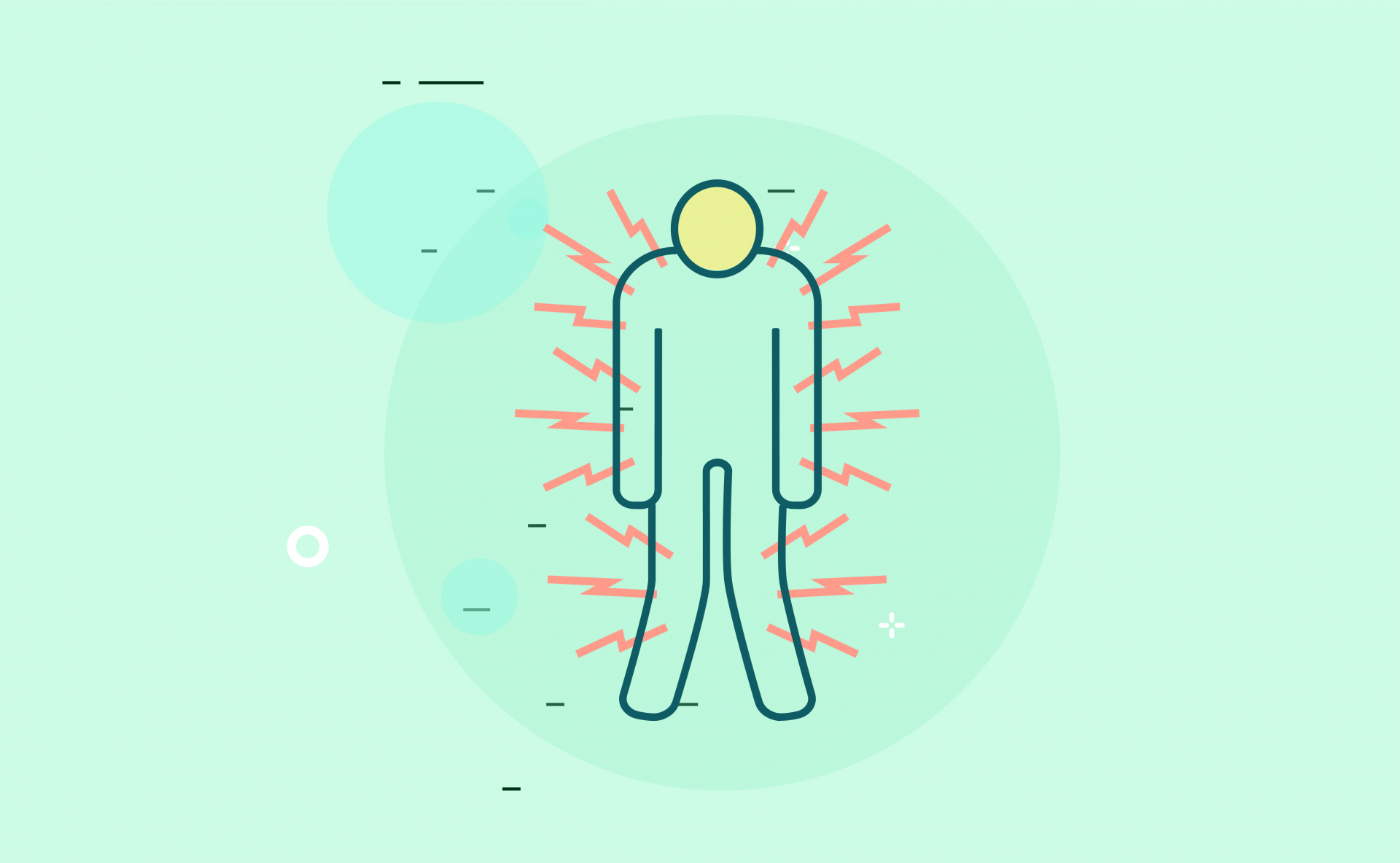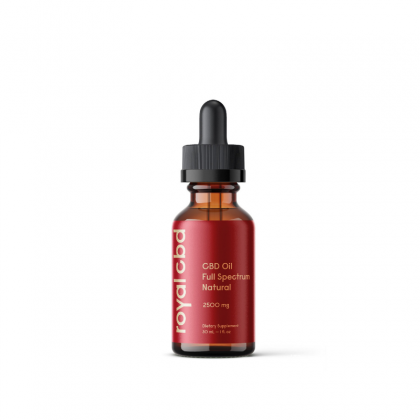| Total CBD: | 500 – 2500 mg |
| Potency: | 16.6 - 83.3 mg/mL |
| Cost per mg CBD: | $0.12 – $0.18 |
| Extract Type: | Full-spectrum |
| THC Content: | <0.3% |

Evidence based
CBD For Fibromyalgia: Research, Benefits, & Dosage
Cannabis has shown potential as a safe and natural alternative for treating chronic pain and inflammation involved with fibromyalgia.
Here’s how it works.
Roughly 2% of the population will receive a diagnosis of fibromyalgia in their life-time [1].
There’s no cure for fibromyalgia — and most treatment options and their effectiveness will vary from person to person [2].
Let’s take a look at fibromyalgia and the effects of CBD on this chronic condition. This may shed some light on why CBD is so popular among people suffering from fibromyalgia.
Benefits of CBD for Fibromyalgia
CBD is a promising alternative for people suffering from fibromyalgia. The primary benefits come from CBDs’ ability to affect the endocannabinoid system — which in turn affects neuronal and microglial activity.
In basic terms, CBD is able to influence the behavior of cells that transmit pain and cells that cause inflammation in the central nervous system.
When the stress response is managed effectively, symptoms of fibromyalgia can be ameliorated.
CBD is also useful as an anti-inflammatory, and analgesic for the condition, which are two of the most prominent side-effects of the condition.
The benefits of CBD oil for fibromyalgia include:
- Alleviates chronic pain & inflammation
- May support sleep quality
- Fights anxiety & depression
1. Alleviates Chronic Pain
There’s a wealth of anecdotal reports on the effectiveness of CBD at reducing chronic pain, such as the kind experienced in fibromyalgia. In a study on joint pain, preclinical studies show that there is an interaction between CBD and the ECS, which may explain CBD’s analgesic properties [7].
2. May Improve Sleep
Another study showed that CBD interacts with astrocyte activity. This is yet another piece of information that can explain why taking CBD is able to affect a myriad of neurological symptoms. Astrocytes are a type of cell in the brain that regulates the synaptic activity and inflammation [8].
CBD has shown positive effects on regulating the quality and quantity of sleep thanks to its calming and anti-anxiety properties [9].
3. Fights Anxiety & Depression Symptoms
Various preclinical trials and small double-blind studies have shown that CBD works well to treat anxiety and depression along with other neurological issues.
One of the primary ways CBD works to relieve symptoms of depression is by eliminating underlying inflammation in the brain — which is closely linked with depression [10].
What’s The Dose of CBD For Fibromyalgia?
The dose of CBD for fibromyalgia can vary a lot from one person to the next. Everybody responds differently, so it’s important to start low and go slow with your CBD dosing. If you are new to taking CBD, it’s advised to start on the smallest dose according to the instructions of the product you are using. Gradually increase by 5-10 mg until you feel you have reached your optimal dose.
By starting at a lower dose and gradually increasing over time you can find the right dose without going overboard and causing negative side-effects like sedation or dry mouth.
Most people with fibromyalgia require a higher dose of CBD to receive maximum benefits.
Keep a journal of your dosages, timings, and symptoms to find or adjust the amount that is optimal for you.
Fibromyalgia patients will often take CBD oil as drops below the tongue, and/or apply a topical CBD cream or gel onto the affected areas.
Related: The Best CBD:THC Ratio for Fibromyalgia.
CBD Dosage Calculator
Is CBD Safe?
CBD is safe, well-tolerated and rarely produces side effects even with high doses. When side-effects are experienced, they tend to be mild, including things like dizziness, dry mouth, or sedation.
There’s evidence that tolerance to the compound doesn’t develop, unlike other treatment options like opioid medications (such as Oxycontin) [14]
It’s important to note that research is based on using pure, high-quality CBD oils that don’t contain synthetic additives or preservatives.

What is Fibromyalgia?
Fibromyalgia is a chronic illness that causes widespread pain throughout the body — often accompanied by symptoms such as fatigue, insomnia, depression, and problems with memory and concentration.
Fibromyalgia isn’t life-threatening — but it has a tremendous physical and social impact on those affected.
There is increasing evidence that stress and depression play a significant role in the development of fibromyalgia.
Scientists have found that the body’s two stress systems — the hypothalamic-pituitary-adrenal (HPA) axis and the sympathetic nervous system — are altered in people with fibromyalgia.
Basically, the HPA axis is the major part of the system that controls your physiological reaction to stress. If this system is dysfunctional, it becomes significantly more difficult to manage stressful situations.
One of the most common side-effects is chronic, widespread pain — a symptom widely exhibited in fibromyalgia.
Symptoms of Fibromyalgia
Each person will have his or her own set of symptoms, which can be mild, moderate or severe. Symptoms can even disappear from time to time, lasting weeks, months, or years before coming back.
The Most Common Symptoms of Fibromyalgia Include:
- Widespread pain
- Sensitivity to cold and heat, light, smell
- Extreme fatigue
- Irregular sleeping patterns
- Cognitive difficulties often referred to as “fibro fog”
Common Comorbidities of Fibromyalgia
- Irritable bowel syndrome (IBS)
- Restless leg syndrome (RLS)
- Migraines and headaches
- Interstitial cystitis or painful bladder syndrome
- Depression and anxiety
- Skin problems
What’s The Cause of Fibromyalgia?
We still don’t know what causes fibromyalgia, but it appears to be factors like genetics, past illnesses, injuries, or past emotional and physical stress.
Risk factors for fibromyalgia include:
- Family history of fibromyalgia
- Physical or emotional injury or trauma
- Illness such as a virus or infection
- Lupus, ankylosing spondylitis (spinal arthritis) or rheumatoid arthritis
- Anxiety, depression, and emotional stress
- Sleep deprivation
- Smoking
- Being overweight
- Heightened stress
How is Fibromyalgia Diagnosed?
Over time, guidelines have changed in the methods used to diagnose fibromyalgia. In the past, doctors would diagnose fibromyalgia by identifying specific tender points in at least 11 of 18 specified sites. Patients also must have been experiencing widespread pain for at least the past 3 months.
Now, more recent guidelines have been developed as a simple, practical criterion for diagnosis involving the following:
- Widespread pain lasting more than three months.
- Symptom severity score involving fatigue, waking unrefreshed, and poor cognitive function.
- No underlying disorders that could explain symptoms.
There are no specific lab tests that can confirm a diagnosis, though doctors may recommend blood tests, x-rays, and specialized scans, such as nuclear medicine and CT scans.
Tests used to diagnose fibromyalgia may include:
- Full blood count — including testing for adrenal and thyroid function. Hypothyroidism can cause symptoms that mimic those of fibromyalgia
- Vitamin D testing — a deficiency in vitamin D can cause similar symptoms to fibromyalgia
Doctors will try to rule out everything that can be tested for, ensuring the exclusion of autoimmune conditions that can mimic the symptoms of fibromyalgia. If nothing else is identified and the patient checks the criteria for fibromyalgia, a diagnosis is made.

How Is Fibromyalgia Treated?
Fibromyalgia can be difficult to treat. This is primarily because the condition presents slightly different for everybody.
Since there is no direct cause for fibromyalgia, treatment of symptoms requires trial and error, repeated doctor visits, and a combination of both lifestyle changes and medication.
An individual treatment plan may include some or all of the following:
- Physical therapy
- Counseling
- Exercise program
- Antidepressant medications
- Meditation and yoga
- Acupuncture
- Reflexology
- Massage therapy
Common Therapies for Fibromyalgia:
- Physical therapy — physical therapists can guide you with exercises that will improve muscular strength, flexibility, and stamina to reduce pain. Hydrotherapy (water-based exercise) can be beneficial.
- Psychotherapy — counseling may help to relieve symptoms of stress and provide skills in stress resilience.
- Occupational therapy — occupational therapists can make the necessary adjustments in your workplace to make tasks easier to perform.
Common Medications for Fibromyalgia:
- Pain Medications — used alone or in combination, paracetamol and non-steroidal anti-inflammatory drugs (NSAIDs) are often used to treat pain. Benzodiazepines such as Valium are commonly used to relax muscles and treat anxiety and tension.
- Narcotic analgesics or opioids — these medications are used when all other medications have failed to help treat the symptoms of fibromyalgia. They can potentially form a dependency and are usually only prescribed for a short period. Oxycodone (OxyContin) is a common opioid analgesic.
- Antidepressants — Selective serotonin reuptake inhibitors (SSRIs) such as Cymbalta, Savella, Prozac or Paxil may help with pain and sleep disturbances; the same goes for tricyclic antidepressants such as Pamelor and Elavil. However, adverse events, tolerance development, and weight gain are common side effects of some antidepressants.
- Antiepileptic drugs — these are used for their sleep-promoting and anxiolytic actions. Lyrica and Neurontin can be prescribed for their ability to slow down nerve signals from the muscles to the brain to reduce pain and muscle spasms. Side effects of dependency and weight gain are frequent deterrents for its use.
It can be dangerous to mix many of these medications with CBD, so only do so with your doctor’s permission.
Lifestyle & Self-Care Tips For Fibromyalgia
Fibromyalgia is a chronic condition that is affected by many factors, including diet and lifestyle choices. Therefore, treatment needs to involve daily habits and routines.
Here are the most important lifestyle and self-care tips to incorporate into a treatment plan for fibromyalgia.
1. Relaxation Strategies
Meditation and mindfulness therapies can help to relieve stress and reduce symptoms of fibromyalgia.
Here are some common ways to promote relaxation:
- Deep, rhythmic breathing — meditation and relaxation exercises are profoundly helpful for stress-related conditions like fibromyalgia. There are a plethora of useful applications that can be downloaded to your device for free to help you get started. Alternatively, you can attend meditation or yoga classes.
- Counseling — talking through your stresses and concerns with a professional counselor is particularly beneficial if you have a history of physical or emotional trauma.
- Biofeedback — a machine that can help read the body’s signals to reduce pain.
- Behavioral cognitive therapy — visit a behavioral cognitive therapist who can help you to manage emotional stress.
2. Sleep Hygiene
Sleep is essential for optimal health. When we’re sleep-deprived, it becomes more difficult to manage stress, leading to increased symptoms in fibromyalgia sufferers.
Adults should get at least 7-8 hours of sleep per night.
Sleep Hygiene Tips:
- Set a routine — ensure you’re following regular bedtime and wake-up times, including weekends!
- Meditation — meditation in the evenings primes the nervous system for sleep by relaxing the body and turning down the stress response.
- Warm baths with Epsom Salts — magnesium salts relax the muscles and ease the tension that may be keeping us up at night.
- Minimize noise — wearing earplugs can help us get to sleep faster for people sensitive to sounds.
- Avoid napping during the day — if you need to nap, try to keep it to less than 30 minutes, and no later than 3 pm.
- Avoid stimulants — like caffeine, alcohol, and cigarettes (especially after 1 pm)
3. Regular Exercise
Exercise may be the last activity on your mind when you’re experiencing pain and fatigue. However, appropriate gentle exercises including walking, swimming, cycling, Pilates, yoga, and Tai Chi can help to ease pain and improve mood.
Remember to take small steps and don’t overdo it.
4. Eat a Balanced Diet
Eating a well-balanced diet and avoiding processed foods high in saturated fats and sugar can reduce inflammation and ease symptoms of fibromyalgia.
People with fibromyalgia often see their symptoms worsen when consuming foods with additives such as MSG and nitrates, and artificial sweeteners.
Eat to Increase Energy
Excessive fatigue is one of the most common symptoms of fibromyalgia. Eating certain whole and fresh foods high in fiber and low in sugar can provide you with more energy. Increase your intake of foods such as nuts, seeds, and dark leafy greens.
Follow a Low FODMAP Diet
A recent study found that following a low fermentable oligo-di-mono-saccharides and polyols (FODMAP) diet is a nutritionally balanced approach that leads to both weight loss and reduced severity of fibromyalgia symptoms [11]. FODMAP diets are not meant to be used for the long term but can be useful during flare-ups.
Go Vegetarian or Vegan
A recent 2018 study found that following a lacto-vegetarian diet for just 4 weeks resulted in reduced pain and improved body composition. The study also involved physiotherapy; therefore the combination of treatments may have improved the outcome [12].
Increase Your Magnesium
There may be a link between magnesium deficiency and fibromyalgia symptoms. Increase your consumption of magnesium-rich foods such as green leafy vegetables, nuts and seeds, legumes, and seafood.
Avoiding Gluten
Studies have shown that removing foods that contain gluten can reduce pain and inflammation, even if you don’t have Celiac disease [13].

Key Takeaways: Using CBD For Fibromyalgia
Fibromyalgia can be a debilitating condition to live with, heavily impacting an individual’s mental health and motivation.
While there is no cure for fibromyalgia, there are steps you can take to reduce and better manage the symptoms.
More clinical trials are needed — however, research shows that CBD can be a safe and effective treatment in relieving many of the symptoms associated with the condition, significantly improving quality of life.
References:
- (2017, October 11). Fibromyalgia | Arthritis | CDC. Retrieved from https://www.cdc.gov/arthritis/basics/fibromyalgia.htm#targetText=Fibromyalgia affects about 4 million,2% of the adult population.
- (2019, February 20). Fibromyalgia. Retrieved from https://www.nhs.uk/conditions/fibromyalgia/
- Walitt, B., Klose, P., Fitzcharles, M. A., Phillips, T., & Häuser, W. (2016). Cannabinoids for fibromyalgia. The Cochrane database of systematic reviews, 7(7), CD011694. DOI:10.1002/14651858.CD011694.pub2
- Lu, H. C., & Mackie, K. (2016). An Introduction to the Endogenous Cannabinoid System. Biological psychiatry, 79(7), 516–525. DOI:10.1016/j.biopsych.2015.07.028
- Lafaye, G., Karila, L., Blecha, L., & Benyamina, A. (2017). Cannabis, cannabinoids, and health. Dialogues in clinical neuroscience, 19(3), 309–316.
- Perucca E. (2017). Cannabinoids in the Treatment of Epilepsy: Hard Evidence at Last?. Journal of epilepsy research, 7(2), 61–76. DOI:10.14581/jer.17012
- Jiller, R. J., & Miller, R. E. (2017). Is cannabis an effective treatment for joint pain? Clinical and Experimental Rheumatology, 35(5), 59–67. Retrieved from https://www.clinexprheumatol.org/article.asp?a=12225
- Kozela, E., Juknat, A.,& Vogel, Z. (2017). Modulation of Astrocyte Activity by Cannabidiol, a Nonpsychoactive Cannabinoid. International journal of molecular sciences, 18(8), 1669. DOI:10.3390/ijms18081669
- Shannon, S., Lewis, N., Lee, H., & Hughes, S. (2019). Cannabidiol in Anxiety and Sleep: A Large Case Series. The Permanente Journal, 23, 18–041. DOI:10.7812/TPP/18-041
- Campos, A. C., Fogaça, M. V., Scarante, F. F., Joca, S., Sales, A. J., Gomes, F. V., … Guimarães, F.S. (2017). Plastic and Neuroprotective Mechanisms Involved in the Therapeutic Effects of Cannabidiol in Psychiatric Disorders. Frontiers in pharmacology, 8, 269. DOI:10.3389/fphar.2017.00269
- Marum, A. P., Moreira, C., Carus, P. T., Saraiva, F., & Guerreiro, C. S. (2017). A low fermentable oligo-di-mono-saccharides and polyols (FODMAP) diet is a balanced therapy for fibromyalgia with nutritional and symptomatic benefits. Nutrición Hospitalaria, 34(3), 667. https://doi.org/10.20960/nh.703
- Martínez-Rodríguez, A., Leyva-Vela, B., Martínez-García, A., & Nadal-Nicolás, Y. (2018). [Effects of Lacto-vegetarian diet and stabilization core exercises on body composition and pain in women with fibromyalgia: randomized controlled trial]. Nutricion Hospitalaria, 35(2), 392–399. https://doi.org/10.20960/nh.1341
- Isasi, C., Colmenero, I., Casco, F., Tejerina, E., Fernandez, N., Serrano-Vela, J. I., … Villa, L.F. (2014). Fibromyalgia and non-celiac gluten sensitivity: a description with remission of fibromyalgia. Rheumatology International, 34(11), 1607–12. https://doi.org/10.1007/s00296-014-2990-6
- Hurd, Y. L., Yoon, M., Manini, A. F., Hernandez, S., Olmedo, R., Ostman, M., & Jutras-Aswad, D. (2015). Early Phase in the Development of Cannabidiol as a Treatment for Addiction: Opioid Relapse Takes Initial Center Stage. Neurotherapeutics: the journal of the American Society for Experimental NeuroTherapeutics, 12(4), 807–815. DOI:10.1007/s13311-015-0373-7
More Health Conditions to Explore
-
Conditions Related to Health Benefits
- CBD For Allergies: Can This Cannabinoid Ease Symptoms?
- Top 10 CBD Oils For Back Pain
- Can CBD Help With Menstrual Cramps?
- CBD for Sciatica: How It Works, Safety, Drug Interactions, & Best Products
- Is CBD a Viable Treatment for Cerebral Palsy?
- CBD Oil For Sleep
- CBD For Psoriasis: Can CBD Help to Alleviate Symptoms?
- Traumatic Brain Injury (TBI)
- Arthritis
- Anxiety & Depression
- Weight Loss
- ADD & ADHD
- Anorexia
- Alzheimer’s Disease & Dementia
- Addiction
- ALS (Amyotrophic Lateral Sclerosis)
- Antibiotic Resistance
- Asthma
- Atherosclerosis
- Autism
- Acne
- Bipolar Disorder
- Pain
- Crohn's Disease & Ulcerative Colitis
- Diabetes
- Epilepsy
- Endocrine Disorders
- Fibromyalgia
- Fatty Liver Disease
- Glaucoma
- Hypertension
- Heart Disease
- Huntington's Disease
- Inflammation
- Irritable Bowel Syndrome (IBS)
- Kidney Disease
- Migraine Headaches
- Muscle Recovery
- Multiple Sclerosis
- Motion Sickness
- Metabolic Syndrome
- Neurodegeneration
- Cancer
- Nausea
- Neuropathic (Nerve) Pain
- Osteoporosis/Bone Health
- Obsessive-Compulsive Disorder (OCD)
- Polycystic Ovarian Syndrome (PCOS)
- PTSD
- Prion/Mad Cow Disease
- Premenstrual Syndrome (PMS)
- Parkinson’s Disease
- Schizophrenia
- Sickle Cell Anemia
- Stroke
-
Conditions Related to Products
- Ranking The Top 13 THC Gummies By Category (Δ8, Δ9, Δ10, HHC, & More)
- Top 10 CBD Oils For Back Pain
- Everything You Need to Know About CBD Sunscreen
- Top 7 CBD Gummies For Sleep & Insomnia
- Top 7 CBD Gummies To Help With Anxiety (2022)
- Best CBD Gummies For Pain (Top-Rated Pain Gummies For 2022)
- Best Hemp Cigarettes (Top 5 Nicotine-Free Smokes)
- Top 5 CBD Lip Balms For 2022
- The Top 7 CBD Face Masks for 2022
- The Best CBD Inhalers For 2022 (& How to Use Them)
- Best Full-Spectrum CBD Vape Juice: What to Look For & How to Use It
- CBD Eye Drops: New Option For Glaucoma?
- CBD Oil For Dogs With Arthritis
- Best CBD Massage Oils In 2022
- Buyer's Guide To The Best CBD Vape Kits In 2022
- CBD Chocolate: Yes, It Exists & It's Just as Divine as it Sounds
- CBD Pre-Rolls & Cigarettes
- Terpene Concentrates
- Best CBD Soaps
- Best CBD Shampoo & Conditioner
- Best CBD Juul Pods
- CBD Isolate Oils
- Full-Spectrum CBD Oils
- Best CBD Lube
- CBD Honey
- CBD Transdermal Patches
- Best Dry Herb Vaporizers
- CBD Oil For Dogs With Epilepsy
- CBD Oil For Dogs With Anxiety
- CBD Oil For Dogs With Cancer
- CBD For Horses
- CBD Chewing Gum
- CBD Pain Cream
- CBD Oil For Cats
- CBD Oil For Dogs
- CBD Hemp Flower
- CBD Suppositories
- Best CBD Gummies for Pain, Sleep & Anxiety Reviewed (2022)
- CBD Teas
- CBD Vape Pens
- CBD Vape Oils
- CBD Coffee
- CBD Drinks & Shots
- CBD Crystals
- CBD Skincare
- Best CBD Oil & Gummies For Kids: Is CBD Safe for Children with Anxiety & ADHD?
- CBD Concentrates
- CBD Bath Bombs
- CBD Capsules
- CBD Sprays
- CBD Dog Treats
-
Conditions Related to Topicals
-
Conditions Related to Oils & Tinctures
-
Conditions Related to Edibles
- Top 7 CBD Gummies To Help With Anxiety (2022)
- Best CBD Gummies For Pain (Top-Rated Pain Gummies For 2022)
- CBD Chocolate: Yes, It Exists & It's Just as Divine as it Sounds
- CBD Honey
- CBD Chewing Gum
- Best CBD Gummies for Pain, Sleep & Anxiety Reviewed (2022)
- CBD Teas
- CBD Coffee
- CBD Drinks & Shots
- CBD Capsules
-
Conditions Related to Gummies
- Ranking The Top 13 THC Gummies By Category (Δ8, Δ9, Δ10, HHC, & More)
- Top 7 CBD Gummies For Sleep & Insomnia
- Top 7 CBD Gummies To Help With Anxiety (2022)
- Best CBD Gummies For Pain (Top-Rated Pain Gummies For 2022)
- Best CBD Gummies for Pain, Sleep & Anxiety Reviewed (2022)
- Best CBD Oil & Gummies For Kids: Is CBD Safe for Children with Anxiety & ADHD?
-
Conditions Related to Hemp Flower
-
-
Conditions Related to Terpenes
-
-
Conditions Related to Cultivation
-
Conditions Related to Concentrates
-
Conditions Related to Delta 8 THC
-
Conditions Related to Delta 9 THC
-
-
-
-
Conditions Related to CBD
- Everything You Need to Know About CBD Sunscreen
- Top 7 CBD Gummies For Sleep & Insomnia
- Top 7 CBD Gummies To Help With Anxiety (2022)
- Best CBD Gummies For Pain (Top-Rated Pain Gummies For 2022)
- Best Hemp Cigarettes (Top 5 Nicotine-Free Smokes)
- Top 5 CBD Lip Balms For 2022
- The Top 7 CBD Face Masks for 2022
- The Best CBD Inhalers For 2022 (& How to Use Them)
- Best Full-Spectrum CBD Vape Juice: What to Look For & How to Use It
- CBD Eye Drops: New Option For Glaucoma?
- CBD Oil For Dogs With Arthritis
- Best CBD Massage Oils In 2022
- Buyer's Guide To The Best CBD Vape Kits In 2022
- CBD Chocolate: Yes, It Exists & It's Just as Divine as it Sounds
- CBD Pre-Rolls & Cigarettes
- Best CBD Soaps
- Best CBD Shampoo & Conditioner
- Best CBD Juul Pods
- CBD Isolate Oils
- Full-Spectrum CBD Oils
- Best CBD Lube
- CBD Honey
- CBD Transdermal Patches
- CBD Oil For Dogs With Epilepsy
- CBD Oil For Dogs With Anxiety
- CBD Oil For Dogs With Cancer
- CBD For Horses
- CBD Chewing Gum
- CBD Pain Cream
- CBD Oil For Cats
- CBD Oil For Dogs
- CBD Hemp Flower
- CBD Suppositories
- Best CBD Gummies for Pain, Sleep & Anxiety Reviewed (2022)
- CBD Teas
- CBD Vape Pens
- CBD Vape Oils
- CBD Coffee
- CBD Drinks & Shots
- CBD Crystals
- CBD Skincare
- Best CBD Oil & Gummies For Kids: Is CBD Safe for Children with Anxiety & ADHD?
- CBD Concentrates
- CBD Bath Bombs
- CBD Capsules
- CBD Sprays
- CBD Dog Treats
-
-
Conditions Related to THC-O
-
-
Conditions Related to Joint Health
-
Conditions Related to Pain Disorders
- Top 10 CBD Oils For Back Pain
- Can CBD Help With Menstrual Cramps?
- CBD for Sciatica: How It Works, Safety, Drug Interactions, & Best Products
- Traumatic Brain Injury (TBI)
- Arthritis
- Pain
- Fibromyalgia
- Glaucoma
- Inflammation
- Kidney Disease
- Migraine Headaches
- Multiple Sclerosis
- Neuropathic (Nerve) Pain
- Premenstrual Syndrome (PMS)
- Sickle Cell Anemia
-
Conditions Related to Autoimmune Disease
-
Conditions Related to Cognitive Health
-
Conditions Related to Metabolic Disorders
-
Conditions Related to Psychological Disorders
-
Conditions Related to Muscles & Bones
-
Conditions Related to Nervous System
- CBD for Sciatica: How It Works, Safety, Drug Interactions, & Best Products
- Is CBD a Viable Treatment for Cerebral Palsy?
- CBD Oil For Sleep
- Traumatic Brain Injury (TBI)
- Anxiety & Depression
- ADD & ADHD
- Anorexia
- Alzheimer’s Disease & Dementia
- Addiction
- ALS (Amyotrophic Lateral Sclerosis)
- Autism
- Bipolar Disorder
- Epilepsy
- Huntington's Disease
- Inflammation
- Migraine Headaches
- Multiple Sclerosis
- Motion Sickness
- Neurodegeneration
- Neuropathic (Nerve) Pain
- Obsessive-Compulsive Disorder (OCD)
- PTSD
- Prion/Mad Cow Disease
- Parkinson’s Disease
- Schizophrenia
-
-
Conditions Related to Reproductive Health
-
Conditions Related to Hormones & Endocrine
-
Conditions Related to Skin Health
-
Conditions Related to Cardiovascular System
-
Conditions Related to Digestive System
-
Conditions Related to Genetic Disorders
-
Conditions Related to For Children









